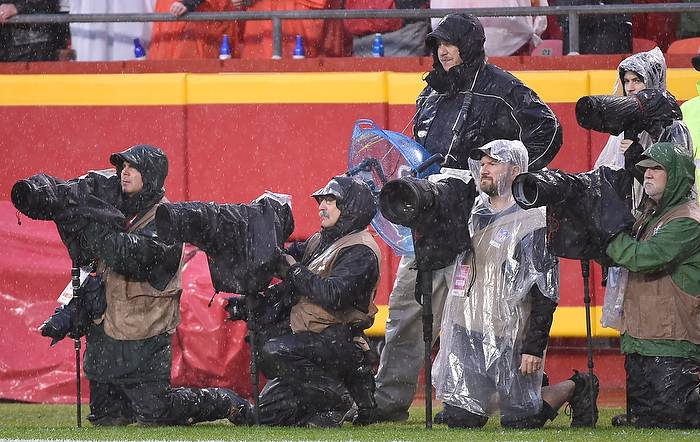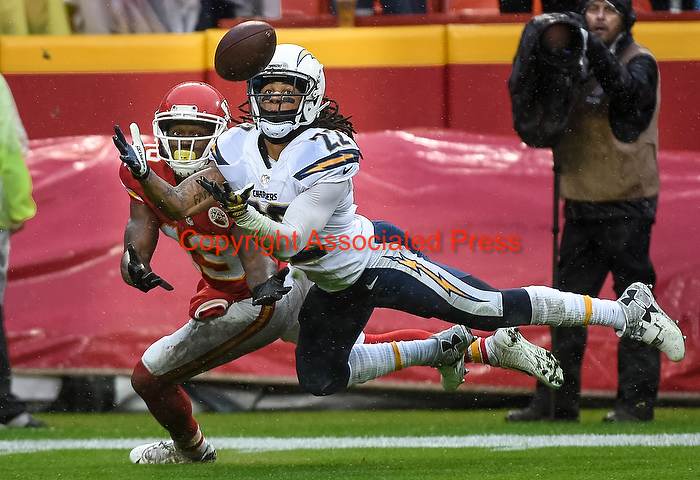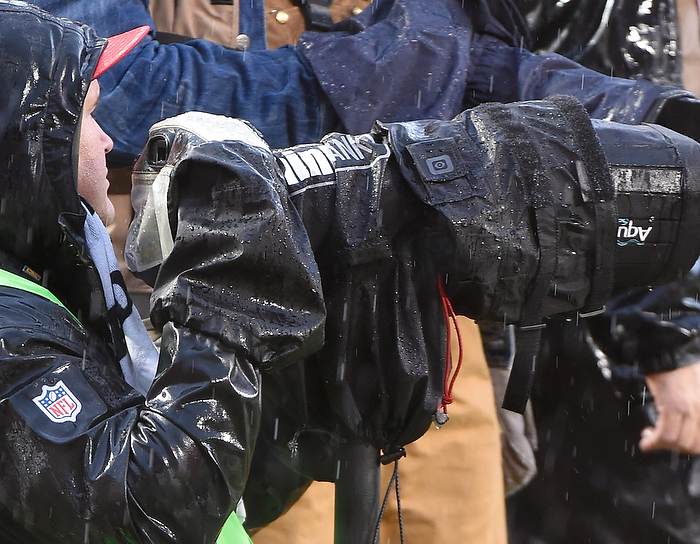Bad weather can make good pictures. Which is about the only reason I was at Arrowhead Stadium Sunday afternoon. For the second home game in a row, we had constant rain. What a pain. On the plus side, the light was nice and soft, meaning no contrast problems or faces hidden in shadow. But shooting in the rain is one of the biggest challenges a photographer can face. Here’s how I deal with it…
I’m a big fan of being prepared. With photography, that means making sure you’ve got everything you might need before you leave the house. Laying out all the gear, checking cameras, lenses, cards and batteries, laptop, AC adapter, card reader – all the stuff you need to do the job regardless of what it is. With rain in the forecast, that list is going to be a bit longer.
The first thing to think about is how you’re going to get from the parking lot to the field. For me that means a big rolling case (Thinktank Airport Security). Many of today’s rollers come with a rain cover, but if you don’t have one, make one out of a kitchen garbage bag. And there’s no point in getting drenched walking from the parking lot. A golf umbrella is my favorite tool for that. Big and strong, it provides a lot of protection.
Next is how to protect the camera gear once on the field. Two big issues here. One, you’ve got to keep water off the front of the lens. Raindrops and glass don’t make for clear photos. While most telephotos lenses have lens hoods, for a driving rain, you might need more. For me that’s provided by a gallon water bottle that I cut down to give me an extension. Taped to the manufacturer’s hood, I can easily add another six inches of protection. The second issue with gear is the camera and lens. Water’s bad for electronics too. If you’re likely to shoot in the rain regularly, or for extended periods, then a camera raincoat by someone like Thinktank is a good investment. Those are designed to give you access to the controls (zoom and focus rings, shutter button, menus, LCD…) while keeping water out. For rare, short outings in rain, there are less expensive plastic options. And really, even a plastic bag, with some rubber bands and tape, can do the job.

I know these guys weren’t happy, but they were well-prepared to do their jobs and cover Sunday’s Chiefs/Chargers game. Nikon D4S, Aperture Priority, ISO 2500, 1/800 at f/4, Nikon 200-400mm f/4 lens. Photo by Reed Hoffmann
Finally, unless you enjoy being wet, make sure you’re prepared personally too. Waterproof boots, waterproof outer pants, waterproof jacket and hat are mandatory. On top of that, I also wear a poncho. Why? Because it lets me have a second camera underneath it along with my fanny pack, and protects them both from the rain except when I need them.
And yes, rain can make for some good photos. If you want to see some of what I shot for the Associated Press from Sunday’s game, here’s one and the rest are in this gallery.

San Diego Chargers cornerback Jason Verrett (22) makes an interception of a pass intended for Kansas City Chiefs wide receiver Jeremy Maclin (19) during the first half of their NFL football game in Kansas City, Mo., Sunday, Dec. 13, 2015. (AP Photo/Reed Hoffmann) Nikon D4S, Aperture Priority, ISO 2200, 1/1600 at f/4.5, Nikkor 200-400mm f/4 lens.


So why is it, that for instance, in last weekends Patriots/Cowboys game, one of the cameras had rain on the lens continually throughout the game. You could hardly see anything? Thanks
I didn’t see the game, David, but my guess is that it may have been a camera that was difficult to get to, like the camera on wires above the field. In that case, they’d only have had an opportunity to clean the lens at halftime.